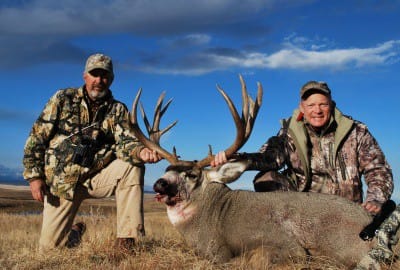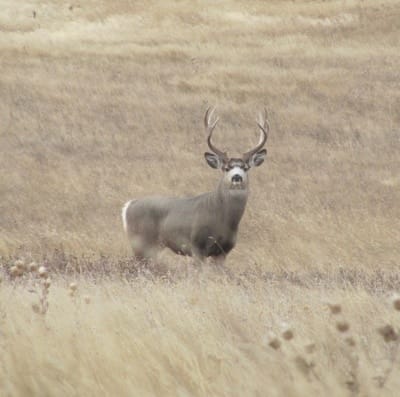
By the 1930s virtually all big game species were at a low ebb in the United States, a long-term decline accelerated by meat hunting during the Depression and the disastrous drought of the Dust Bowl. During summers from school in the late Thirties my Dad wrangled horses in the Frazier Park area west of Denver, great elk and mule deer country today, and he doesn’t recall ever seeing a deer or elk track. During World War II most wildlife got a massive break. Millions of potential hunters were away, ammo and fuel were scarce, and America’s focus was on defeating the Axis. Especially in the West, numbers rebuilt, and in time there were lots of mule deer.
When it started and when it stopped depended on the area, but we think of the 1950s into perhaps the 1970s as the Golden Age of Mule Deer Hunting. I caught the latter part of it; I hunted in Colorado, Wyoming, and Montana between the mid-60s and the mid-70s, and I saw some awfully good mule deer come into camp…but I was just a kid, a tag was a tag, and I didn’t shoot any big ones. And then it was over. Nobody knows exactly why, but there are probably lots of reasons: Little trapping and no poisoning, so more predators; sagebrush eradication, ranchettes, and ski resorts, so less winter range; a few bad winters; and, as the years passed, more and more elk. Elk and mule deer don’t compete directly, but the last 30 years of exploding elk populations (the reasons for which are also not fully understood) have generally seen a correlative slide in mule deer numbers. When I was a kid hunters took “30-inch mule deer” on a fairly regular basis, but I was already hunting farther horizons, and a big mule was something I could always obtain easily…until I couldn’t.
Oh, sure, I took some decent mule deer. I took a fine buck in Nevada in 1978, another awesome buck in Colorado in 1981, a couple of good desert bucks in Mexico, and so forth. And, given what a do for a living, a lot of “4x4s” and, if I must admit, some lesser bucks along the way. But I’ve known for a very long time that, in the exuberance of youth, I missed what was once a very simple task…and now has become one of North America’s most difficult chores: Taking a really big mule deer. Not just big, really big!
There are, of course, many ways to define “really big.” By Boone and Crockett standards this means both big and perfect, with any disparity from one side to the other counting as deductions against the total score. Safari Club International counts only typical points for “typical” antler configuration, everything for “non-typical”—but no deductions. Most mule deer hunters speak first of antler spread as in a “30-inch buck,” which is generally taken to mean outside spread, a measurement that neither B&C nor SCI uses. Spread is impressive. The only thing is, it says nothing about number of points or antler mass, or if the spread is attained by a “cheater,” or extra point off, that juts sideways and gives it extra width. I took a buck like that in Wyoming in 2007, truly an awesome mule deer for today—we saw him before the season and called him “Stickers.” He was a basic 4×4 with some “cheaters” or “kickers” that brought him to a 32-inch spread. He was a great buck, and the best mule deer I’d taken in many a year…but we won’t talk about his record book score, either gross or net; and his mass was okay but not dramatic.
Honestly, having let the good old days go past, I never really expected to take what I think of as a monster mule deer. Let’s not talk about “score,” which I’m not all eaten up with anyway. Nor, necessarily, spread, which is really just a measurement of air. Let’s talk instead about antler mass, long points, and the sheer “impressiveness” factor.

In 2009 I was fishing for salmon at my buddy Jim Rough’s Black Gold Lodge in Rivers Inlet, British Columbia. He makes a living fishing, but he’s really a hunter, so we started talking hunting and he showed me some photos of some amazing mule deer he’d taken with Duane Nelson on the Milk River in southern Alberta, right on the Montana line. I knew that, thanks to careful management and very limited tags, Alberta was producing some great deer…but not like the photos he showed me. So we tried for the first time in 2010. Well, everybody was apologetic, but we had blizzard conditions that limited mobility, and my sense was that this was not a good year for antler growth—but we saw a lot of bucks with promise.
So we tried again in 2011. We saw more deer, and probably some better bucks—antler growth was getting better—but the wind blew 60 miles per hour the whole week, and in that prairie country we had to dig the deer out of the deepest coulees. So maybe this place wasn’t so good…or maybe I should give it one more try, and hope the weather gave us a break? I looked at Jim’s pictures again. Better try once more!
The previous two years we’d hit the end of the season, when the rut would be peaking—but the weather was awful. This time we tried the first week, although I don’t think it really matters so much—luck is luck, weather is weather, and the 100,000-acre ranch only allows a tiny handful of permits. But this year, for the first time, Ken told me that antler growth was “good,” and while bowhunting for himself he had seen several bucks we should try to find.
I wasn’t in a hurry. I had time, and I hate the ever-increasing expense of changing plane tickets. But at mid-morning on opening day we saw the most amazing mule deer I’ve ever seen in my life. His bases looked like baseball bats. Extremely wide? No, but incredibly tall, with long points and some extras. We watched him go over a ridge, then I made a stalk and caught him in a little coulee. I never looked at the antlers again—the decision was made. To be honest, I never looked at the whole deer again. I was focused on his shoulder, and the pocket behind his shoulder, and when he turned and offered me an almost broadside shot I squeezed the trigger.
At face value he was a great deer, too good to pass on the first day or last…but he’d been alone when I’d seen him, so I didn’t realize that he was one of those giant Canadian bucks, well over 300 pounds in body weight, possibly 350. So when I walked up to him he kept getting bigger and bigger. He was the kind of buck I could have taken with relative ease in the 1960s…and that made it even sweeter nearly 50 years later.
The Union Sportsmen’s Alliance website is designed to provide valuable articles about hunting, fishing and conservation for members of AFL-CIO affiliated labor unions and all sportsmen and sportswomen who appreciate hunting and fishing and want to preserve our outdoor heritage for future generations. If you would like your own story and experience from the outdoors to be considered for our website, please email us at [email protected].







